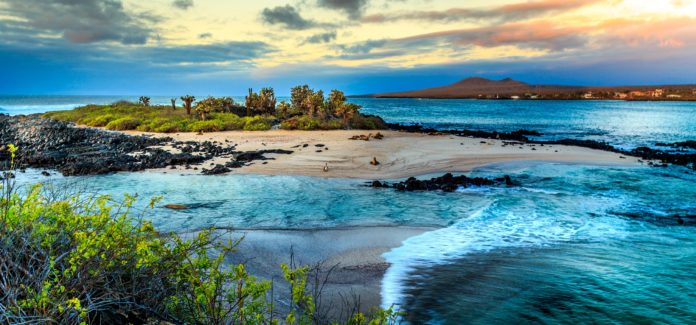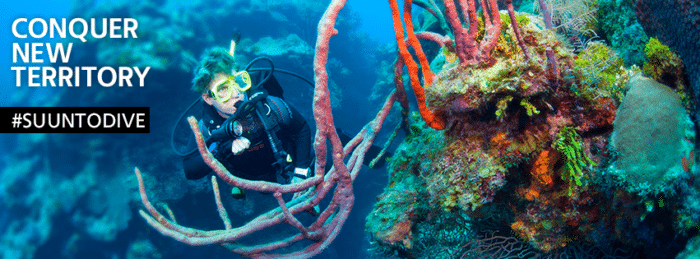The Galapagos is an archipelago of volcanic islands found either side of the equator, within the Pacific Ocean, approximately 563 miles west of Ecuador.
When thinking about the Galapagos Islands (those who have not visited), some imagine them to be small islands of paradise, similar to tropical locations such as the Bahamas or Hawaii. However, they are far from it. Some of the islands are in fact almost completely devoid of vegetation and consist of volcanic craters and rocks, which vaguely resemble the surface of the moon.
This incredible isolated group of islands, with its fragile ecosystem, has gained its almost mythological status due to its awesome biodiversity. However, you do not have to be a biologist, ornithologist or even a marine biologist to appreciate one of the very few places on earth that has not been affected (too much) by the human footprint.
Scuba diving around the Galapagos Islands can only be described as awe-inspiring and is a place found on many divers bucket lists. This place provides the perfect medium for observing large marine life as well as small marine life, not to mention the incredible ‘bait-balls’ that you may find yourself being swallowed up by, during certain times of the year.
Not only should the Galapagos Islands be seen within the water, but they are also home to many adventures on land. There is never a dull moment when visiting Galapagos.
There are just so many incredible diving sites within the Galapagos Islands; almost too many to choose from, so (from my own experiences as well as others) here are some of the top dive sites within Galapagos that SHOULD NOT BE MISSED.
Location
Gordon Rocks

Gordon Rocks has to be number one on this list and is by far my favorite dive site in the Galapagos Islands. Known as the ‘Washing-Machine’ to the locals, this site is only recommended for advanced scuba divers or above.
Situated in a large volcanic crater with a sandy bottom, this site is known for its super-strong currents that blow between large pinnacles of rock, which can make this a tricky dive for even the most accomplished of divers and is why this site has been given the name ‘washing machine’. At times, the current can become so strong that you are told to hold on to the rocky bottom surrounding the sand and adapt into the ‘front crawl’ position, pulling yourself in the direction of the dive plan.
However, don’t let the currents put you off. Gordon Rocks are home to some of the most magnificent marine life on the planet. From schools of hammerhead sharks to large numbers of golden rays, turtles, barracuda, stingrays, moray eels and even at times the majestic manta ray.
If you are an advanced diver who dives on a regular basis, then DO NOT miss this dive site.
Seymour Channel – North Seymour Island
North of the main island of Santa Cruz, North Seymour is one of the very first dive sites that I visited and is made up of 2 beautiful dive sites. It’s perfect for all levels of scuba diver and should not be missed. As well as seeing the incredible turtles, sea lions, eagle rays and huge numbers of reef fish, you will most certainly get a chance to see the endemic Galapagos garden eels by the hundreds. Look closely, as you may think you are looking at marine vegetation, but in fact, there are hundreds if not thousands of garden eels covering the seabed at these locations. Hundreds of white-tip reef sharks can be found at their ‘cleaning stations’ as well as schools of hammerheads.
Daphne Island -Daphne Major and Daphne Minor
Daphne Island is located between Santa Cruz and Santiago Islands. The majority of tourists are restricted from visiting both Daphne Major and Daphne Minor by the Galapagos National Park, however visiting the dive sites surrounding these islands should not be missed by any diver.
Daphne Major is home to remnants of US World War 2 machinery as well as bombshells, which are great to look at. This dive is usually a drift dive where you can see reef fish, coral walls, white–tip reef sharks, huge schools of tuna, moray eels, and sea turtles. You will also get to see the Galapagos black coral, which is absolutely beautiful. This site is also home to slopes, walls, caves, and platforms, which make exploring all the better.
Daphne Minor provides a similar experience to Daphne Major, with an added extra of underwater remains, where lava used to flow.
The currents found at these dive sites are minimal to moderate, allowing fledgling divers to practice their skills or even participate in a drift dive.
Cousin’s Rock
Cousins Rock, located by Santiago Island is an incredible dive site. Not only is it home to so many unbelievable species of marine life, but it also has a great deal to offer advanced divers. From sloping rock plate formations to walls, which drop into the abyss, you cannot miss this diving spot.
Divers will come across seahorses, octopi, frogfish, hammerheads, Galapagos black coral and of course the infamous Galapagos sharks. If you’re looking for a “once in a lifetime experience”, this is the place to go. At one point we had giant Manta rays above, turtles below and Lobos Marinos (Sealions) playing with our bubbles. This is definitely one for your list.
Lobos Island

Lobos Island is located on San Cristobal Island and is named for the sheer amount of sea lions that inhabit this area. If you’re looking for an easy dive where you can really become one with nature, then this dive site is for you.
The waters surrounding San Cristobal are littered with starfish, rays, reef fish, turtles, eagle rays, golden rays and sometimes even marine iguanas. One of my favorite dives happened at this dive site, where a medium-sized sea lion decided to play a game of ‘eat my bubbles’ and ‘bop you on the nose’. Be prepared for this dive to have extremely playful sea lions pulling on your fins or even playing hide and seek with you.
Kicker Rock

Kicker Rock is located just off the coast of San Cristobal Island and is made up of 2 rocks jutting out the water. It was given the name ‘Kicker Rock’ due to its amazing resemblance to a shoe or a boot. This location is great for both scuba and snorkeling, so if you want to take a day off from diving, but still desperate to get into the water, then Kicker Rock is the perfect location.
Diving or snorkeling between these two rocks, you will be able to follow an incline of boulders, divers will get a chance to see a variety of fish including wrasses, surgeonfish, starfish, angelfish and may even see Galapagos sharks or hammerheads. The small channel between these two rocks can sweep some amazing creatures past you including turtles, large rays and sometimes marine iguanas. This is normally quite a slow and enjoyable dive, however, be prepared as the currents can pick up almost in a heartbeat.
Bartholomew Point
Bartholomew Point is located off the Coast of Bartholomew Island. Bartholomew island is not only known for its amazing dive sites, but it’s also home to some of the most breath-taking sites on land. However, diving at Bartholomew Point is an experience like non-other.
This dive site is more for the adventurous divers out there, looking to see fascinating lava and rock formations as well as an incredible number of marine species. Prior to my first dive at this site, we were told to look out for a Bait-ball that had been seen in the area. We were given instructions to stay put if you find yourself engulfed in the bait-ball and to stay close to our buddy as well as the guide. Within 15mins into our dive, a giant ball of metallic shimmery light came towards us and then the water turned dark. Before we knew it, our whole group was in the middle of what can only be described as the inside of a tornado, tremendous bluster surrounding us but a moment of total calm in the center. It was definitely an experience that I will never forget.
This site is also home to incredible whizzing penguins on the surface, acrobatic sea lions, white-tip reef sharks, pelagic fish, reef fish, rays, and turtles. Galapagos Penguins are the only penguin to exist north of the equator. Bartholomew’s Pinnacle Rock is known to provide amazing photographic opportunities for tourists.
There are so many incredible dive sites found throughout the Galapagos Islands and if you have a site that hasn’t been mentioned in this post, then feel free to let us know about your experiences in the comments below.
Brought To You By
This guide is brought to you by Suunto. We recommend that you use a Suunto Dive Computer when diving one of these dive sites. Suunto is the world’s leading dive computer designer and manufacturer providing diving instruments for recreational, technical and freediving. You can find out more at Suunto.com.


